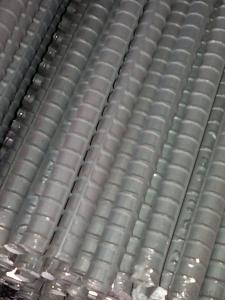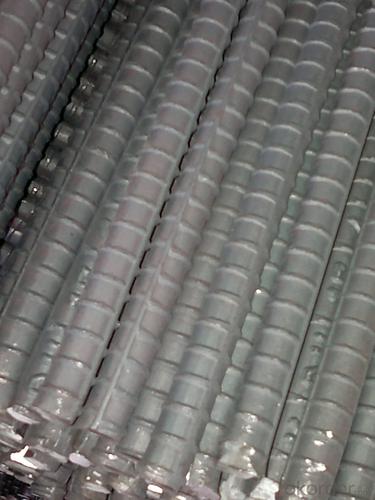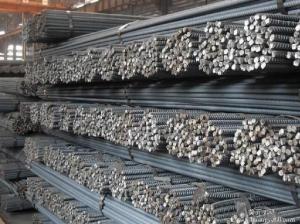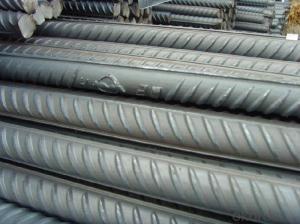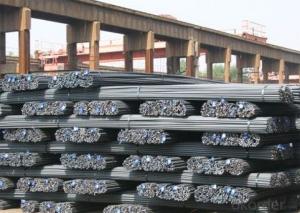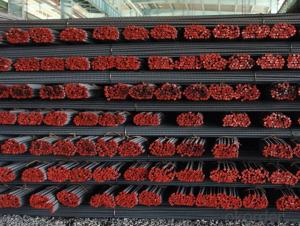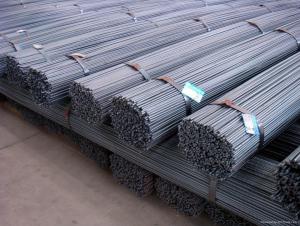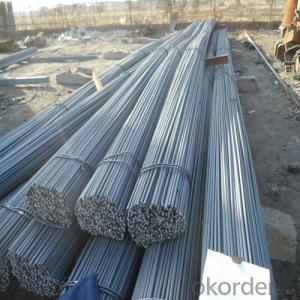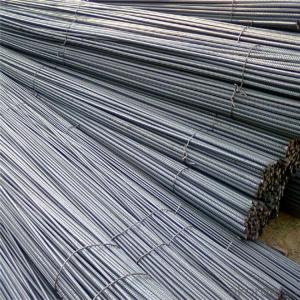Hot-Rolled Steel Deformed Bar Rebar Deformed Steel Bar
- Loading Port:
- Tianjin
- Payment Terms:
- TT OR LC
- Min Order Qty:
- 50 m.t.
- Supply Capability:
- 30000 m.t./month
OKorder Service Pledge
OKorder Financial Service
You Might Also Like
Product Description:
OKorder is offering Hot-Rolled Steel Deformed Bar Rebar Deformed Steel Bar at great prices with worldwide shipping. Our supplier is a world-class manufacturer of steel, with our products utilized the world over. OKorder annually supplies products to European, North American and Asian markets. We provide quotations within 24 hours of receiving an inquiry and guarantee competitive prices.
Product Applications:
Hot-Rolled Steel Deformed Bar Rebar Deformed Steel Bar are ideal for structural applications and are widely used in the construction of buildings and bridges, and the manufacturing, petrochemical, and transportation industries.
Product Advantages:
OKorder's Hot-Rolled Steel Deformed Bar Rebar Deformed Steel Bar
are durable, strong, and resist corrosion.
Main Product Features:
· Premium quality
· Prompt delivery & seaworthy packing (30 days after receiving deposit)
· Corrosion resistance
· Can be recycled and reused
· Mill test certification
· Professional Service
· Competitive pricing
Product Specifications:
deformed steel bar grade 40
material: HRB400, BS4449 GR460B
size: 8-36mmx12m.
short delivery time with bulk or container
packing: Mill standard export packing in bundles/coil, around 2tons/bundle.
country of Origin: China
delivery Time: Within a 35 days
Shipment: by bulk vessel or by container
Leading goods:
section steel:angles,channels,I-beam,H-beam;
coils:cold/hot rolled coils,PPGI,galvanized coils,plate,checkered plate,cutting steel plate,steel strip;
wire rod:steel wire,deformed wire,bar;
pipe:seamless pipe,rectangular pipe,welded pipe,spiral welded pipe,pipe fittings;
stainless steel:steel sheets,stainless steel strips,stainless bar,stainless tube;
special:weathering steel,shipbuilding steel;
construction steel:C-channel,Z-channel,T-bar,high-speed divider plate,corrugated steel plate,steel grating.
Advantage:
We are the spot supplier, Six huge warehouses which can hold 20,000 MT goods.
It makes the cost lower than others,we can provide the competitive price for you.
Delivery time:
Normal sizes can be provided in 7days, the others should be ready in 30---45 days.
Further treatment:
We can offer cutting,painting,drilling holes,bending,threading, welding,galvanization,packing etc.
Security interest:
We have already passed the ISO9001, BV and SGS authentication which makes the quality secured.
If you have the interest in any of the products we can provided, pls don't hesitate to connect with me. Looking forward to cooperate with you.
FAQ:
Q1: Why buy Materials & Equipment from OKorder.com?
A1: All products offered byOKorder.com are carefully selected from China's most reliable manufacturing enterprises. Through its ISO certifications, OKorder.com adheres to the highest standards and a commitment to supply chain safety and customer satisfaction.
Q2: How do we guarantee the quality of our products?
A2: We have established an advanced quality management system which conducts strict quality tests at every step, from raw materials to the final product. At the same time, we provide extensive follow-up service assurances as required.
Q3: How soon can we receive the product after purchase?
A3: Within three days of placing an order, we will begin production. The specific shipping date is dependent upon international and government factors, but is typically 7 to 10 workdays.
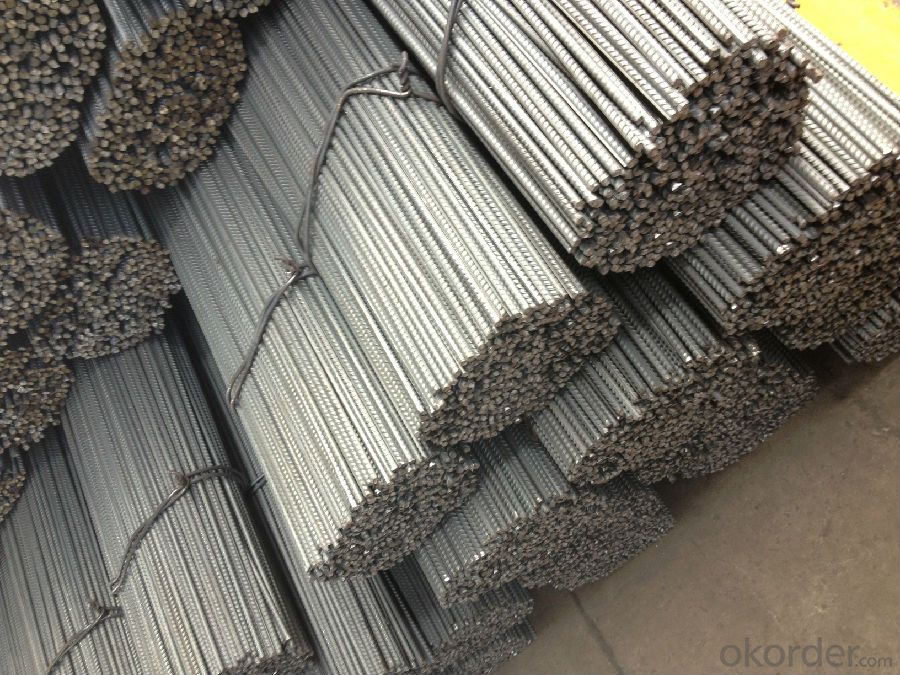

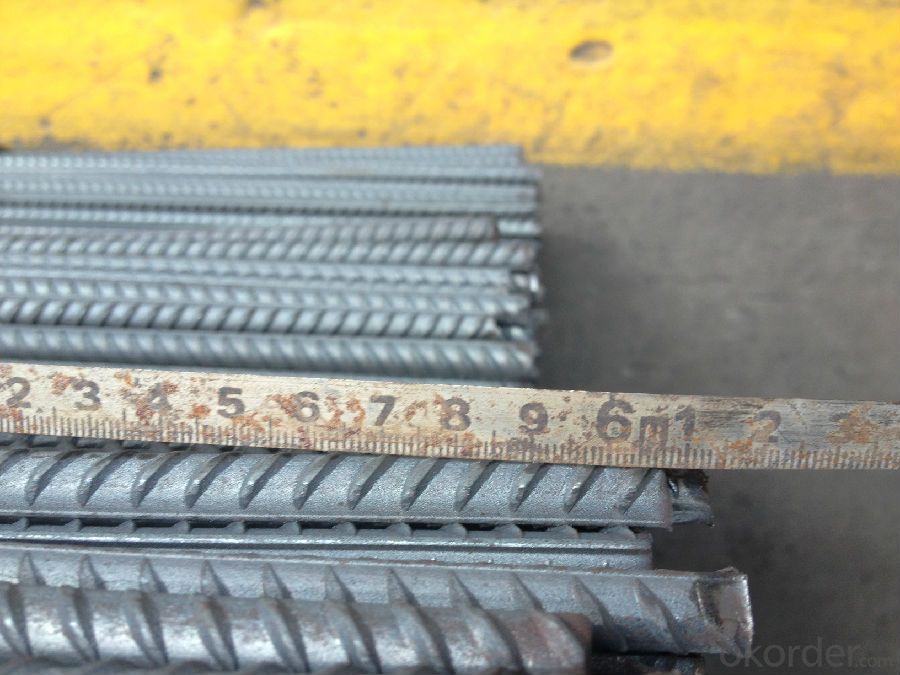
- Q: How do steel rebars reinforce concrete?
- The structural stability of concrete is reinforced by steel rebars, which provide additional strength. Concrete possesses strength under compression but is weak when subjected to tension. To counteract this weakness and enhance its tensile strength, steel rebars are embedded in the concrete. The rebars function as reinforcement by absorbing the tensile forces that arise when a structure undergoes bending or stretching. In the presence of such forces, the rebars evenly distribute the load across the concrete, preventing cracks and failure. This is particularly crucial in buildings, bridges, and dams, where the concrete must withstand diverse external forces. Furthermore, the rebars help regulate the expansion and contraction of the concrete resulting from temperature changes. Since steel and concrete have similar coefficients of thermal expansion, steel rebars assist in minimizing stress caused by temperature fluctuations, thus reducing the likelihood of cracking. Additionally, the bond between the steel rebars and the concrete is vital for effective reinforcement. The rough surface of the rebars ensures excellent adherence to the surrounding concrete, enabling them to function as a composite material. This bond facilitates the transfer of stress from the concrete to the rebars, thereby enhancing the overall strength and durability of the structure. To summarize, steel rebars reinforce concrete by providing tensile strength, distributing loads, controlling temperature-induced stress, and establishing a robust bond with the concrete. The combination of concrete and steel results in a reinforced concrete structure capable of withstanding various external forces and maintaining its structural integrity over time.
- Q: Are there any specific safety precautions to be taken while handling steel rebars?
- There are several safety measures that need to be taken into account when handling steel rebars. Here are some important factors to consider: 1. Personal Protective Equipment (PPE) is essential. It is crucial to wear the appropriate gear, including safety goggles or glasses, gloves, and steel-toed boots. These items will help safeguard against potential eye injuries, cuts, and crushed toes. 2. Proper lifting techniques must be employed when handling rebars. This involves bending at the knees, maintaining a straight back, and utilizing leg muscles to lift the load. Twisting or jerking movements should be avoided to prevent strains or sprains. 3. Rebars should be stored in an organized and secure manner. They should not be leaned against walls or other structures to avoid falling and causing harm. 4. The sharp edges of rebars should be handled with caution. Careful handling is necessary to prevent cuts or punctures. Wearing protective gloves is recommended to minimize the risk of hand injuries. 5. When transporting rebars, it is crucial to ensure they are secured properly. This prevents movement or falling off the vehicle. Appropriate restraints such as ropes or straps should be used to secure the load safely. 6. It is important to be mindful of any overhead power lines or live electrical sources in the working area. Maintaining a safe distance from these sources prevents accidental contact with the rebars, which can conduct electricity. 7. Communication and awareness among workers are key. Constantly communicating with others in the vicinity ensures that everyone is aware of the presence of rebars. This helps prevent accidental injuries caused by tripping or colliding with the rebars. By adhering to these safety precautions, the risk of accidents or injuries while handling steel rebars can be minimized. It is also important to undergo proper training and comply with any specific safety guidelines provided by your employer or industry regulations.
- Q: Can steel rebars be used in reinforced masonry structures?
- Yes, steel rebars can be used in reinforced masonry structures. Rebars, which are short for reinforcement bars, are commonly used to strengthen and provide structural integrity to masonry elements such as walls, columns, and beams. The rebars are inserted into the masonry units and then embedded in mortar or grout, forming a strong bond between the steel and the masonry. The use of steel rebars in reinforced masonry structures offers several advantages. Firstly, it enhances the load-bearing capacity of the structure, allowing it to withstand higher loads and resist deformation. This is especially important in areas prone to seismic activity or heavy wind loads. Secondly, the steel rebars help to distribute stress more evenly throughout the structure, preventing localized failures and increasing overall durability. Additionally, the use of rebars can improve the crack resistance of masonry, reducing the risk of cracks and improving the structural performance. It is worth noting that the design and installation of steel rebars in reinforced masonry structures must comply with specific codes and standards to ensure proper safety and performance. The size, spacing, and placement of the rebars are determined based on structural calculations and engineering principles. Adequate cover of masonry around the rebars is also crucial to prevent corrosion and maintain their structural integrity over time. In conclusion, steel rebars can definitely be used in reinforced masonry structures to enhance their strength, load-bearing capacity, and durability. Proper design, installation, and adherence to building codes are essential to ensure the successful integration of rebars with masonry.
- Q: How are steel rebars used in water treatment plants?
- Steel rebars are commonly used in water treatment plants to reinforce concrete structures such as tanks, pipelines, and treatment units. These rebars provide strength and stability to the concrete, ensuring that the structures can withstand the harsh conditions and pressures of water treatment processes.
- Q: What is the maximum diameter of steel rebars used in residential construction?
- The maximum diameter of steel rebars typically used in residential construction is around 20 millimeters or 3/4 of an inch.
- Q: What is the elongation of steel rebars?
- The elongation of steel rebars pertains to how much they can deform or stretch before fracturing or breaking. It measures the ductility or flexibility of the steel rebars. Elongation is typically expressed as a percentage of the rebar's original length. The elongation of steel rebars varies based on the grade or type of steel used and the manufacturing processes involved. In general, steel rebars have a relatively high elongation compared to materials like concrete or timber. This makes them suitable for applications that require flexibility and resistance to deformation, such as reinforced concrete structures. Considering the elongation of steel rebars is crucial in structural design and construction. It affects the rebar's ability to withstand loads, particularly when subjected to tension or bending forces. Higher elongation values indicate a greater capacity for the rebar to stretch and deform without breaking, enhancing the overall performance and safety of the structure. To ensure the proper selection and utilization of steel rebars, it is essential to refer to the relevant standards and specifications provided by regulatory bodies and industry organizations. These guidelines outline specific requirements and recommendations for the elongation of steel rebars, along with other mechanical properties, to guarantee the structural integrity of construction projects.
- Q: How to calculate the theoretical elongation of finishing thread steel?
- The theoretical elongation of fine thread steel is calculated by L=P.L/ (E.A), P is force, L steel bar is longer, E is elastic, and A is area.
- Q: How do steel rebars improve the load-carrying capacity of concrete?
- The load-carrying capacity of concrete is enhanced by steel rebars, which strengthen and reinforce the material. By embedding steel rebars within the concrete, tensile strength is provided to an otherwise tension-weak material. Concrete is known for its strength in compression but lacks strength in tension. The steel rebars serve as a support system within the concrete, ensuring a more even distribution of the load and preventing the occurrence of cracks or failure. When a load is applied, the rebars resist the tensile forces and contribute to holding the concrete together, thereby improving its load-carrying and distribution capabilities. Moreover, steel rebars also enhance the ductility of concrete. Ductility refers to the capacity of a material to deform without fracturing. The inclusion of steel rebars in the concrete increases its flexibility and ability to withstand higher levels of stress and strain without experiencing failure. This is particularly valuable in structures that may face earthquakes, as their ability to absorb and dissipate energy is crucial for maintaining overall integrity. In conclusion, steel rebars bolster the load-carrying capacity of concrete by providing tensile strength, promoting even load distribution, preventing cracks, and enhancing overall ductility. This reinforcement and strength enhancement greatly enhance the stability and durability of concrete structures.
- Q: How are steel rebars used in the construction of power plants?
- Steel rebars are commonly used in the construction of power plants due to their strength and durability. These reinforced steel bars are used to provide structural support and reinforcement to various concrete elements in the power plant construction. One of the primary applications of steel rebars in power plant construction is in the construction of foundations and structural members. Power plants require strong and stable foundations to support the heavy equipment and machinery, as well as withstand the dynamic loads and vibrations. Steel rebars are embedded within the concrete foundation to enhance its structural integrity and resistance to compressive and tensile forces. In addition to foundations, steel rebars are also used in the construction of walls, columns, and beams in power plants. These elements play a crucial role in supporting the overall structure and ensuring its stability. By adding steel rebars to the concrete mix, the resulting reinforced concrete components can bear higher loads and resist cracking or deformation under stress. Furthermore, steel rebars are utilized in the construction of containment structures in nuclear power plants. These structures are designed to confine any potential release of radioactive materials in case of accidents or incidents. By incorporating steel rebars into the concrete walls and floors of these containment structures, their strength and resistance to impact and penetration are significantly enhanced, thereby improving the safety and security of the power plant. Overall, steel rebars play a vital role in the construction of power plants by providing reinforcement to concrete elements and ensuring the structural integrity and longevity of the facility. Their use enhances the strength, durability, and safety of the power plant, making it capable of withstanding various operational and environmental conditions.
- Q: How do steel rebars contribute to the structural soundness of a building?
- Steel rebars are crucial components in the construction industry as they play a significant role in ensuring the structural soundness of buildings. These reinforcing bars, commonly known as rebars, are made of steel and are embedded within concrete to provide additional strength and reinforcement. One of the primary ways steel rebars contribute to the structural soundness of a building is by increasing its tensile strength. While concrete is excellent when it comes to handling compressive forces, it is relatively weak in terms of tension. When a building is subject to various loads, such as those caused by wind, earthquakes, or even its self-weight, it experiences both compressive and tensile forces. By adding steel rebars to concrete, the tensile strength of the overall structure is significantly enhanced. This prevents the concrete from cracking or failing under tension, ensuring the building's stability and durability over time. Furthermore, steel rebars also improve the overall ductility of a building. Ductility refers to the ability of a material to deform under stress without fracturing. Concrete, being a brittle material, lacks ductility and tends to fail abruptly when subjected to excessive stress. By incorporating steel rebars, the concrete-reinforced structure gains the ability to absorb and distribute energy, allowing it to undergo controlled deformations without sudden failure. This increased ductility ensures that the building can withstand dynamic loads, such as those generated during an earthquake, and reduces the risk of catastrophic collapse. In addition to improving tensile strength and ductility, steel rebars also enhance the overall stability and load-bearing capacity of a building. By distributing the load more evenly across the structure, they help to minimize localized stress concentrations, preventing potential weaknesses or failure points. This distributed load-bearing capacity ensures that the building can support its intended weight and withstand the forces acting upon it. Moreover, steel rebars also contribute to the longevity of a building by providing protection against corrosion. Steel is vulnerable to rust when exposed to moisture and air, which can weaken its structural integrity. However, rebars are often coated with epoxy or other anti-corrosion materials to prevent rusting. This protective layer ensures that the steel remains intact and maintains its strength over time, further enhancing the structural soundness of the building. In summary, steel rebars play a vital role in ensuring the structural soundness of a building. They increase the tensile strength of concrete, improve its ductility, enhance load-bearing capacity, and protect against corrosion. By incorporating steel rebars, buildings can withstand various loads, resist cracking, and ensure long-term stability and durability.
Send your message to us
Hot-Rolled Steel Deformed Bar Rebar Deformed Steel Bar
- Loading Port:
- Tianjin
- Payment Terms:
- TT OR LC
- Min Order Qty:
- 50 m.t.
- Supply Capability:
- 30000 m.t./month
OKorder Service Pledge
OKorder Financial Service
Similar products
Hot products
Hot Searches
Related keywords
